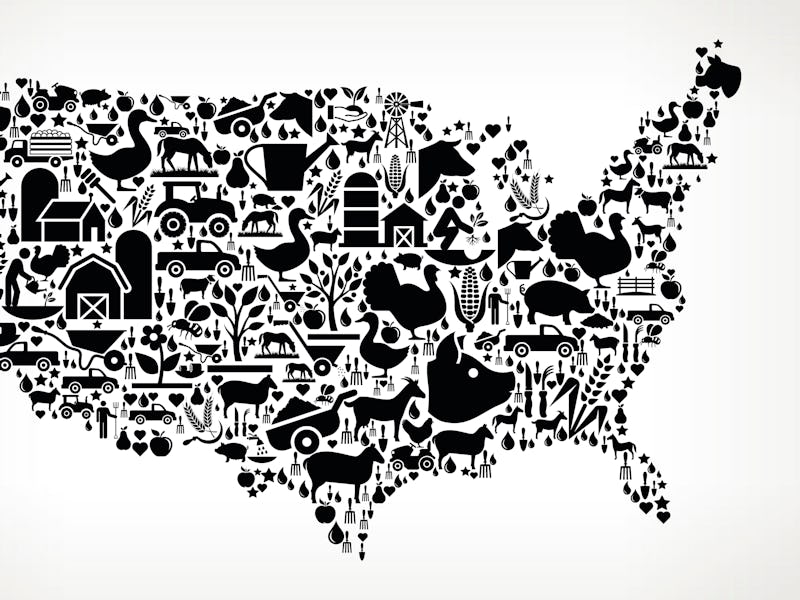"Food miles" map shows how easy it is to eat locally, depending on where you live
A new study pinpoints the best American regions for eating locally.

For years, "eat local" has been a refrain of eco-conscious eating. More recently, social distancing-inspired gardens have many of us eating closer to home than usual.
A new study looks at how feasible it is for people to buy 100 percent of their food from local sources. The answer, the research shows, may come down to two factors:
- Where you live
- What you're willing to eat
The research team measured which US cities have the agricultural land necessary to feed everyone within about 150 miles from home, and published their findings Monday in the journal Environmental Science & Technology.
The geographical region that produces food for a population is known as a foodshed. The size of a foodshed, measured in "food miles," tells researchers how far food has to travel to feed the members of a population.
Food miles vary based on whether something grows in the ground or comes from animals — which require land for growing feed, grazing, and the disposing of manure. Diets that rely on more animal products demand more resources and require larger foodshed to keep up the supply.
Researchers analyzed 378 metropolitan centers across the United States to determine the size of their foodsheds, based on factors including agricultural land available, productivity, and population. They estimated how human diets with varied meat consumption would shape a city's foodshed, based on the cultivation the diet would involve.
The seven diets considered ranged from vegan to the current "mainstream" American diet, which includes eating a lot of meat.
For those who eat that mainstream diet, this map, in particular, shows how easy it is to eat local in cities across the United States:
The map's colors show the size of the foodshed for each city in the study. Green represents a foodshed of 155 miles or smaller, while yellow, orange, and red zones involve traveling much farther. People living in the northwestern and the interior United States have the most access to a local diet, the research shows. Think of states like Oregon, Washington, and much of California.
Areas lining the eastern seaboard — which runs up the east coast from Florida to Maine — were among the least accessible.
In their analysis, the researchers modeled what land would look like based on three types of cultivation: cultivated cropland, perennial forage cropland, and grazing land. Then they estimated what human diets would be supported as proportions of each land type change.
Annual land requirements, per person, based on agricultural land type.
When the researchers determined foodshed size based on how Americans eat today, the resulting map varies widely from region to region. Cities in the northeast, southeast, and southwest are more heavily populated than the center of the country, for instance, so they have to travel further to feed everyone.
Foodshed size would shrink, the researchers argue, if people begin to limit consumption of animal-based foods — something climate scientists call for anyway. Two separate recent studies each called for seriously cutting animal products as both a measure against climate change and one toward preserving biodiversity.
In the new study, researchers argue that lowering the amount of animal-based foods a city needs will make it increasingly more regionally self-reliant. Under a vegan or vegetarian diet, many populations could harvest 100 percent of their food within 155 miles (250 kilometers), the study reports.
No man's land — Under any of the seven diet scenarios the researchers modeled, excess land remains. These areas aren't used to grow food; what is done with them has big implications for conservation.
Currently, most land not reserved for farming is used to grow crops for biofuel — a US export and billion-dollar industry. If cities were to prioritize local eating, there would be an opportunity to reshape how land is used for American agriculture. For example, those decisions could devote more, or less, land to conservation efforts.
Study author Christian Peters is an associate professor at Tufts University. Peters explained that changing up food systems would have to come along with policy changes.
"It would be important to make sure policies for supporting local or regional food production benefit conservation and create opportunities for farmers to adopt more sustainable practices," Peters said in a statement. "Policies should also recognize the capacity of the natural resources in a given locale or region--and consider the supply chain, including capacity for food processing and storage."
Abstract: In the long term, food systems must heed natural resource limits. Localized production and dietary changes are often suggested as potential solutions. However, no U.S. analyses fully evaluate the feasibility to scale localization across a range of diets. We therefore modeled the biophysical capacity for regional food systems based on agricultural land area and productivity, population, and 7 diet scenarios ranging in meat-intensity, from current consumption to vegan. We estimated foodshed size, colloquially known as “food miles” for 378 U.S. metropolitan centers, in a hypothetical nationwide closed system that prioritizes localized food. We found that foodshed size (weighted average distance traveled) for three land types ranged from 351–428 km (cultivated cropland), 80–492 km (perennial forage cropland), and 117–799 km (grazing land). Localized potential varies regionally: foodsheds are generally larger in the populous Northeast, Southeast, and Southwest than in the Northwest and the center of the country. However, depending on consumption of animal-based foods, a sizable proportion of the population could meet its food needs within 250km: from 35%–53% (cultivated cropland), 39%–94% (perennial forage cropland, 100% for vegan), and 26%–88% (grazing land, 100% for ovolacto-vegetarian and vegan). All seven scenarios leave some land unused. This reserve capacity might be used to supply food to the global market, grow bioenergy crops, or for conservation.